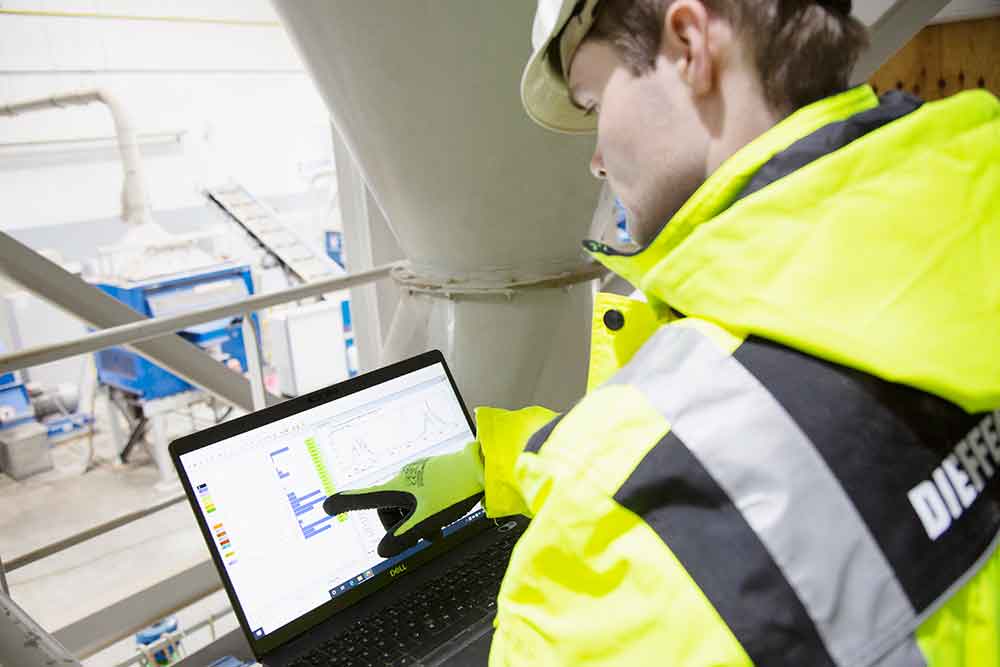Dieffenbacher Emission Control Systems
Dieffenbacher’s emission control solutions include emission measurements and dryer and press emission control systems. Emission measurements help plant operators understand which emissions are present and determine the type and amount of emissions. For example, using state-of-the-art methods, uncomplicated in-house emission measurements can be taken on stacks downstream of the dryer or the press exhaust system. This includes measuring parameters such as total organic carbon (TOC) and many different substances such as water, carbon dioxide, carbon monoxide, nitrous oxide, methane, ethane, propane, formaldehyde, methanol and other gases. Dust in the exhaust gas can also be measured using additional equipment. Subsequent correlation analyses of production parameters and emissions provide a better understanding of plant emissions.

The Dryer Emission Control System cleans dryer exhaust gases using an inline scrubber in compliance with local environmental standards. The main components are the unique inline scrubber and water treatment and distribution systems. The inline scrubber efficiently separates dust particles from the gas stream. Optional auxiliary equipment captures water-soluble VOCs, notably formaldehyde. The Dryer Emission Control System is applicable for horizontal and vertical operation and costs less than an electrostatic filter. It also impresses with its low freshwater demand, reliable design for high uptime and small space requirements.
The Press Emission Control System cleans exhaust gases from the press through a washing process. Dust and condensable fractions of exhaust gases are bound to fine water droplets. These solid and liquid parts are separated in the inline scrubber. Pre-Absorber units can be supplied to reduce VOC emissions (volatile organic compounds), particularly formaldehyde. As a fluid-optimized system, the Press Emission Control System is highly energy-efficient. Like the Dryer Emission Control System, it is characterized by low freshwater demand and small space requirements.
Latest News
Raute Opens Service Center, Kirov, Russia
Raute Group's newly inaugurated Service Center is the company's second Service Center in Russia. It was opened to ensure Raute's capability to meet its customers' needs better and serve the Kirov region plywood mills more effectively by offering shorter delivery times...
Arauco Gets Graying PB Mill Going
Arauco Gets Graying PB Mill Going ARAUCO held a ribbon-cutting ceremony April 16, 2019 at its new particleboard and lamination facility in Grayling, Mich. Executives from ARAUCO, ARAUCO North America, as well as customers and public officials from Chile and the...
Idaho Central Credit Union Arena To Use Engineered Wood
Idaho Central Credit Union Arena To Use Engineered Wood The University of Idaho broke ground on its long-awaited Idaho Central Credit Union (ICCU) Arena. The 4,200-capacity engineered wood mass-timber facility is slated to open in 2021 as home court for Vandal...
Tolko’s Armstrong And Soda Creek Lumber Mills To Take Downtime
Tolko Industries announced its Armstrong and Soda Creek lumber operations would take downtime during the weeks of May 27 and June 3. “High log costs and weak market conditions continue to impact our lumber operating footprint in British Columbia,” says Vice President...
Texas BMP Monitoring Shows Steady Improvement
A 28-year program to monitor logging Best Management Practices (BMPs) implementation on east Texas timber harvest sites shows overall 93.8% BMP implementation in 2018 across all land ownerships. That’s a solid improvement in the last 20 years—the implementation rate...
Find Us On Social
Newsletter
The monthly Panel World Industry Newsletter reaches over 3,000 who represent primary panel production operations.
Subscribe/Renew
Panel World is delivered six times per year to North American and international professionals, who represent primary panel production operations. Subscriptions are FREE to qualified individuals.
Advertise
Complete the online form so we can direct you to the appropriate Sales Representative. Contact us today!
